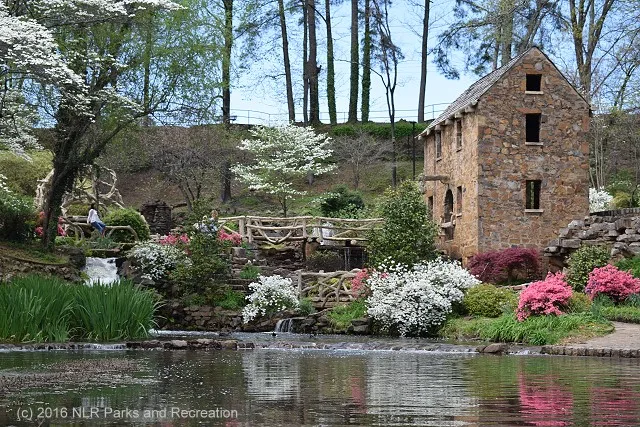HISTORY OF THE OLD MILL
In 1931, Justin Matthews, developer of the Lakewood neighborhood of North Little Rock, contracted for the construction of a replica of an old, water-powered grist mill dedicated to the memory of Arkansas’s pioneers. Neither the stone mill building, nor the general layout is a reproduction of any particular mill, but is a familiar design of early Arkansas, designed to fit the contour of a rough area.
The Mill, completed in 1933, is intended to appear abandoned – absent of doors and windows due to thieves or decay – just as old mills that were in service in the early 1800s had become by the 1930s. The image is that the old gristmill and driving equipment have fallen away or been disconnected from the water wheel; and the water gate on the flume above, although closed, is leaking enough water to turn the old wheel, which is idling away through the years.
Frank Carmean, a German immigrant, worked for Matthews as a builder/architect and designed the basics of the Old Mill. Carmean went on a tour of southwestern states in search of new architectural styles, at which time he “found” Senòr Dionico Rodriguez.
Rodriguez, a sculptor and artist, was responsible for all the details of each piece of concrete work made to represent wood, iron or stone, as well as the designing of the foot bridges and rustic seats. Rodriguez’s secret techniques were so detailed and exacting that you can identify the species of trees in most of his work. Rodriguez worked without any written plans, but there are unwritten stories that describe how Rodriguez envisioned many of his works. “A black locust tree grew in the soft earth on the bank of the little stream. When it reached a certain height it was blown down, but continued to live. A woodsman who wanted to use the trunk of the tree as a footbridge cut off the limbs and…”
During the summer of 1991, Rodriguez’s work at the Old Mill was renovated by Carlos Cortes – Rodriguez’s great nephew and the son of Rodriguez’s assistant Maximo Cortes. The Old Mill, along with other structures located in the Lakewood Property Owners Association Park and Crestwood Park in North Little Rock, were nationally recognized in 1986 by being placed on the National Register of Historic Places.
The Old Mill was given to the City of North Little Rock as a gift by the former Justin Matthews Company on May 24, 1976. Justin Matthews has been described as a visionary real estate developer for conceiving the idea of the Old Mill as part of a comprehensive system of recreational lakes and open spaces in the Lakewood residential area.
Matthews, who had been successful in the cottonseed oil business, had a tremendous impact on the shaping of the city’s neighborhood character starting with his initial efforts during the 1920s and 1930s in developing the nearby Park Hill addition.
Several of the items found in the Old Mill are actual historic relics including:
- the grist mill itself on the first floor dates back to 1828;
- large mill rocks used for seats bear picking (deepening of furrows on the face to increase their grinding capacity) dates of 1823 and 1840;
- mill rocks on the second floor came from the plantation of Tom Knoble, the grandfather of Tom Pugh, in whose honor the Mill is dedicated;
- two original mile stones moved here from a road laid out more than 150 years ago by Jefferson Davis (who later became President of the Confederacy). Along this road (roughly along the route of present day Arkansas State Highway 22), the Cherokee and Choctaw Indians traveled from the present town of Dardanelle into the Indian territory, now Oklahoma;
- three sections of a wrought iron shaft were cut from the stern wheel of a passenger steamboat which traveled the Arkansas River in the 1800s.
STAR OF THE SILVER SCREEN
The Old Mill was filmed in the opening scenes of the famous award-winning movie, Gone With the Wind, which was released in 1939. Although it is not known why David Selznick of Selznick Studios chose the Old Mill, it is believed to be the only remaining structure from the movie.
The Old Mill was honored on the fiftieth anniversary of the movie. It was also the site of the unveiling of the Gone With the Wind commemorative stamp. Through the years, stars from the movie such as Rand Brooks (Charles Hamilton) and Ann Rutherford (Carreen O’Hara) have visited the Mill.
Attesting to its popularity, postcards featuring the Old Mill have been circulated all over the world. It is constantly being photographed and has become a popular site for outdoor weddings. Pugh Memorial Park and the Old Mill serve as hosts for over 200 weddings and 100,000 visitors each year. Please join the thousands of visitors who enjoy the vanished era that has gone with the wind.
ABOUT THE ARTIST
Senòr Dionico Rodriguez, a descendent of the artistic Aztec race, was born on April 11, 1891 in Toluca, Mexico, a town about 60 miles from Mexico City. At the age of 16 he had his first experience with what was to become his life’s work while employed by an Italian artist, Robles Hill, who specialized in creating imitation rocks, caverns, ruins and ancient buildings.
Apparently as a result of the political situation in Mexico, Rodriguez came to Texas in 1925. In 1932, he was hired to do works of sculpture in several parks including the Old Mill. Rodriguez was secretive about the process by which he produced his work. He would mix products in the trunk of his car, slamming it shut if anyone approached or break the jars and peel the labels so no one could copy his work. Not even his assistants knew all of his secrets.
On December 16, 1955 Rodriguez died in San Antonio and was buried there in the San Fernando Cemetery #2. Among other locations, pieces of his sculptures can be found in the Memorial Gardens in Memphis as well as in seven states.

